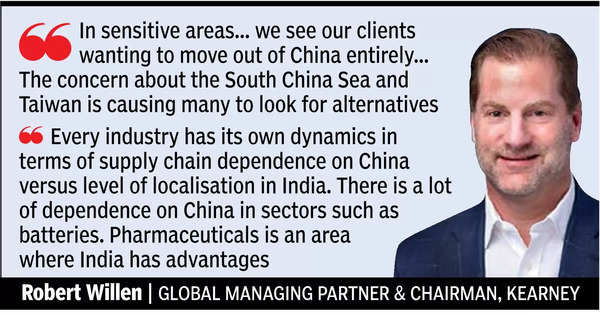Robert Willen, the global managing partner and chairman of Kearney, has been coming to India over the last two decades. After taking the top job at the consulting firm in May 2024, Willen has spent the last couple of months meeting clients and colleagues amid renewed interest in India as companies look to diversify their supply chains beyond China, especially in sectors such as defence and telecom. Excerpts:
How do you see the Indian market?
I have been seeing incredible growth in India and we see a great potential here. There’s a domestic market, it’s not just a service market for the rest of the world. That’s a pivot we want to make in a much stronger way to really serve the domestic market, which is part of the growth of India, the aspiration of India, the positioning of India.
As a consultant, if you were to advise the Indian govt, what would be your strategy to position India?
This is a new era of industrial policy — govts are working with industry, the investor community, making choices, establishing priorities, creating a regulatory framework, attracting investments. Even the US has offered incentives to have local indigenous semiconductor production. Govts need to do that. It doesn’t mean it is for govt to do everything, but it means making some choices, establishing priorities, and investing in different ways to stimulate economic growth and development.

Vietnam and Mexico have emerged as attractive options for investment as part of the China+1 strategy. Where does India fit?
Vietnam has advantages because it is close to China, probably replicating China most efficiently. For instance, if an American company wants to have an operation in Mexico, it’s not that it is replacing China, but it might also be thinking about resilience, speed to market, late-stage customisation, sustainability. It’s about having different sources of supply, different centres to serve customers.
Supplementary or complementary?
Probably complementary. For some, in sensitive areas, it would be replacing. (There) we see our clients wanting to move out of China entirely.
Which sectors would these be?
More security-sensitive sectors such as defence and telecom. These are areas where backup is needed, resilience is needed. The concern about the South China Sea and Taiwan is causing many to look for alternatives.
You work with clients on the supply chain. In the last four years, is there a significant shift in the supply chain from China?
It’s still early, very early. The global shipping trends still show the strength of China; it’s coming down slowly. But we know from our discussions with clients how much they’re also considering alternate sources of supply, thinking about more diversification and resilience in supply chains. All of that’s in early stages. It doesn’t happen overnight. It needs time to develop.
Will the US election results and Trump’s win speed up things?
It’s early days, but it certainly will speed it up if you just take the rhetoric at face value. We talk about deglobalisation and tariffs, a Trump administration will perhaps accelerate that.
Where do you see India figuring in all this?
It is generally good for India. It’s a strong, capable economy which has a lot of resources. It’s an alternative to China in many different ways. The other part is that the US has a low trade deficit with India. Some of the rhetoric that comes out of Trump circles is about rectifying the trade imbalance, which is a positive for India.
We are having several conversations with multinational companies which are talking about what’s the latest in India, what are the emerging opportunities and when should they start looking at the country. Many have small presence and many do not have a presence. We are seeing a lot of interest in conversations about how to scale up, particularly in manufacturing.
Which sectors could be positive for India?
There is a lot of dependence on China in sectors such as batteries. Pharmaceuticals is an area where India has advantages.
